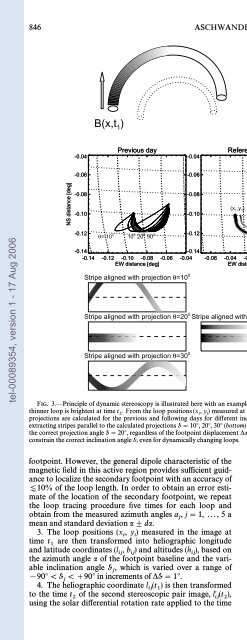Etude de la couronne solaire en 3D et de son évolution avec SOHO ...
Etude de la couronne solaire en 3D et de son évolution avec SOHO ...
Etude de la couronne solaire en 3D et de son évolution avec SOHO ...
Create successful ePaper yourself
Turn your PDF publications into a flip-book with our unique Google optimized e-Paper software.
tel-00089354, version 1 - 17 Aug 2006<br />
846 ASCHWANDEN ET AL. Vol. 515<br />
NS distance [<strong>de</strong>g]<br />
-0.04<br />
-0.06<br />
-0.08<br />
-0.10<br />
-0.12<br />
B(x,t 1)<br />
θ=-10 0<br />
Previous day<br />
10 0 20 0 90 0<br />
-0.04<br />
-0.06<br />
-0.08<br />
-0.10<br />
-0.12<br />
Refer<strong>en</strong>ce day<br />
(x 1,y 1)<br />
(x n,y n)<br />
-0.14<br />
-0.14<br />
-0.14 -0.12 -0.10 -0.08 -0.06 -0.04 -0.06 -0.04 -0.02 0.00 0.02<br />
EW distance [<strong>de</strong>g]<br />
EW distance [<strong>de</strong>g]<br />
Stripe aligned with projection θ=10 0<br />
B(x+Δx,t 2)<br />
-0.04<br />
-0.06<br />
-0.08<br />
-0.10<br />
-0.12<br />
Following day<br />
θ=90 0 20 0 10 0<br />
-10 0<br />
-0.14<br />
-0.00 0.02 0.04 0.06 0.08 0.10<br />
EW distance [<strong>de</strong>g]<br />
Stripe aligned with projection θ=20 0<br />
Stripe aligned with observed projection Stripe aligned with projection θ=20 0<br />
Stripe aligned with projection θ=30 0<br />
Stripe aligned with projection θ=10 0<br />
Stripe aligned with projection θ=30 0<br />
FIG. 3.ÈPrinciple of dynamic stereoscopy is illustrated here with an example of two adjac<strong>en</strong>t loops, where a thicker loop is bright at time t , whereas a<br />
thinner loop is brightest at time t . From the loop positions (x, y ) measured at an intermediate refer<strong>en</strong>ce time t, i.e., t \ t \ t (middle panel in<br />
1<br />
middle row),<br />
projections are calcu<strong>la</strong>ted for the<br />
2<br />
previous and following days<br />
i<br />
for<br />
i<br />
di†er<strong>en</strong>t inclination angles Ë of the loop p<strong>la</strong>ne (left<br />
1<br />
and right<br />
2<br />
panel in middle row). By<br />
extracting stripes parallel to the calcu<strong>la</strong>ted projections Ë \ 10¡, 20¡, 30¡ (bottom) it can be se<strong>en</strong> that both loops appear only co-aligned with the stripe axis for<br />
the correct projection angle Ë \ 20¡, regardless of the footpoint disp<strong>la</strong>cem<strong>en</strong>t *x b<strong>et</strong>we<strong>en</strong> the two loops. The co-alignm<strong>en</strong>t criterion can therefore be used to<br />
constrain the correct inclination angle Ë, ev<strong>en</strong> for dynamically changing loops.<br />
footpoint. However, the g<strong>en</strong>eral dipole characteristic of the<br />
magn<strong>et</strong>ic Ðeld in this active region provi<strong>de</strong>s suffici<strong>en</strong>t guidance<br />
to localize the secondary footpoint with an accuracy of<br />
[10% of the loop l<strong>en</strong>gth. In or<strong>de</strong>r to obtain an error estimate<br />
of the location of the secondary footpoint, we repeat<br />
the loop tracing procedure Ðve times for each loop and<br />
obtain from the measured azimuth angles a , j \ 1, ..., 5 a<br />
mean and standard <strong>de</strong>viation a ^ da.<br />
j<br />
3. The loop positions (x , y ) measured in the image at<br />
i i<br />
time t are th<strong>en</strong> transformed into heliographic longitu<strong>de</strong><br />
1<br />
and <strong>la</strong>titu<strong>de</strong> coordinates (l , b ) and altitu<strong>de</strong>s (h), based on<br />
ij ij ij<br />
the azimuth angle a of the footpoint baseline and the variable<br />
inclination angle Ë , which is varied over a range of<br />
j<br />
[90¡ \ Ë \ ]90¡ in increm<strong>en</strong>ts of *Ë \ 1¡.<br />
j<br />
4. The heliographic coordinate l (t ) is th<strong>en</strong> transformed<br />
ij 1<br />
to the time t of the second stereoscopic pair image, l@ (t ),<br />
2<br />
ij 2<br />
using the so<strong>la</strong>r di†er<strong>en</strong>tial rotation rate applied to the time<br />
interval (t [ t ). We use the di†er<strong>en</strong>tial rotation rate speci-<br />
Ðed by All<strong>en</strong><br />
2<br />
(1973),<br />
1<br />
l@(t ) \ l(t ) ] [13¡.45[ 3¡ sin2 b]<br />
2 1 (t 2 [ t 1 )<br />
. (2)<br />
1 day<br />
The heliographic <strong>la</strong>titu<strong>de</strong> b and altitu<strong>de</strong> h are assumed to<br />
be constant during the consi<strong>de</strong>red<br />
ij<br />
time interval.<br />
ij<br />
5. In the stereoscopic pair image at time t we calcu<strong>la</strong>te<br />
the image coordinates (x@ , y@ ) of the projected<br />
2<br />
loop strucij<br />
ij<br />
ture. Parallel to these loop curves (with typical l<strong>en</strong>gths of<br />
n \ 50È200 pixels) we extract image stripes of some width<br />
s<br />
(n w \ 16<br />
pixels) by interpo<strong>la</strong>ting the image brightness<br />
F(x, y) at the positions of the curved coordinate grid.<br />
6. The str<strong>et</strong>ched two-dim<strong>en</strong>sional image stripes (n ] n<br />
s w<br />
pixels) are th<strong>en</strong> scanned for parallel brightness ridges,<br />
caused by ““ dynamic ÏÏ structures that are co-aligned (or<br />
parallel-disp<strong>la</strong>ced) to the loop projection in image t (for<br />
2

















